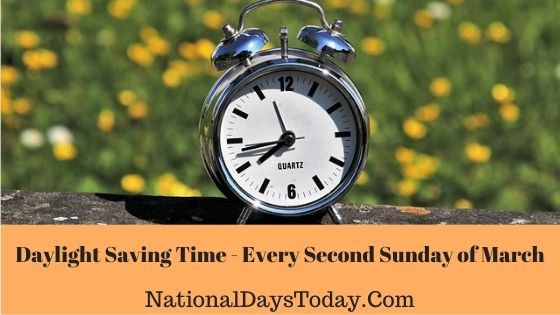Daylight Saving Time
Daylight Saving Time:
This day is observed in most USA and European Union areas on the Second Sunday in the month of March. In the United States, it begins at 2 a.m. while in the European Union, summertime starts and ends at 1 a.m universal time (Greenwich Mean Time).
| Year | Date | Day | Where |
| 2022 | 13th March | Sunday | United States |
| 2023 | 12th March | Sunday | United States |
| 2023 | 11th March | Sunday | United States |
Twitter Hashtags:
#DalightSavingTime
Related: Other National Days Celebrated on March:
Why Daylight Saving Time?
The main purpose of Daylight saving time or summer time (called in many places of the world) is to put daylight to better use. We change our clocks during the summer months to move an hour of daylight from the morning to evening. A few countries change the dates instead of hours. In summers, some people rise before the sun rises and thus, would end up using more energy in the morning if DST was not in effect. However, in winters, the afternoon sunlight and DST advantage compensate for many people and businesses by the morning’s need for more lighting.
In contrast, in the autumn and spring, the advantage is less than an hour. Besides, less electricity was thought to be used because people were home for fewer hours during Spring and Summer since people planned outdoor activities in the extra daylight hours. Some of the advantages and benefits of Daylight Saving Time are as follows:-
- Longer evenings
- The tourism industry gains a profit.
- Less usage of artificial lights
- It has decreased robberies by 7%
- DST contributes to improved road safety by reducing pedestrian fatalities by 13%
- DST’s longer morning hours promote safety
- It shifts summer’s daylight into evening hours when it can be enjoyed more.
- More revenue for companies
- It minimizes energy consumption (It lowers your cost)
Although there are many advantages, there are many disadvantages and cons of Daylight Saving Time as well. Some of them are as follows:-
- It does not save energy
- It can lead to lack of sleep, causing accidents, miscarriages, suicides, and workplace accidents.
- The early evening darkness is linked to depression.
- There is a slightly increased chance of suffering from a heart attack during the DST period.
- There is some extra expense in building DST support in computer systems and maintaining them. New York City invested around 1.6 million US dollars in conducting a dusk and darkness safety campaign.
- It causes a drop in productivity.
- Sleep cycles are harmed since sleep schedules are difficult to adjust.
- It might throw off Circadian Rhythm.
- Agrarian workers take a hit.
- Walking kids to school in darkness
- Problems with natural disaster control
- Concerns from the Jewish communities attending prayer
- Disconnection from the natural world
How can we observe Daylight Saving Time:
Daylight saving time can be observed by setting our clocks twice a year. The clock is set an hour ahead in March around Spring and then behind by an hour in September around Fall (Autumn).
Celebrate it on Social Media –
You can use hashtags and post them on social media
#daylightsavingtime #daylightsaving #DST
Interesting facts on Daylight Saving Time:
- In 2014, researchers reported a 24% increased chance of experiencing a heart attack on Monday, followed by DST.
- A study in 2009 showed that during the week following the spring forward into DST, mineworkers got 40 minutes of sleep. The study was published in the Journal of Applied Psychology.
- Pets notice this time change as well.
- You are unlikely to get robbed during daylight saving time.
- It happens at different times in different countries.
- Benjamin Franklin was half-joking when he suggested it.
- DST negatively affects night owls more than morning people
- Headaches and clusters can increase due to transitions.
- Car accidents increase in the week, followed by the beginning of DST.
- Researchers do not agree that daylight saving conserves energy.
- Drive-in movies were killed due to DST.
On the other hand, there are a lot of myths about Daylight Saving Time. Some of them are mentioned below:-
- America was very first country practicing daylight saving.
- America adopted daylight saving to help out farmers.
- It saves energy
- Farmers loved it
- The extra daylight keeps us healthier and happier.
- It benefits businesses
History of Daylight Saving Time:
DST is used to make daylight’s better use and save energy. It was first observed in 1908 in Thunder Bay, Canada. This idea was introduced by New Zealand scientist George Vernon Hudson and British builder William Willett.
In 1895, Hudson proposed a two hour forward shift in clocks in October and a two-hour shift back in March by presenting a paper to the Wellington Philosophical Society. Although interest in the idea was displayed, it was never followed through.
But in 1905, they independently suggested setting clocks twenty minutes ahead on the four Sundays in April and then switching them back similarly in September, making eight switches per year.
The daylight saving plan caught the attention of British Parliament member Robert Pearce who introduced the bill in the house of commons in February 1908, leading to the first draft of the bill being drafted in 1909. Many sources are known to credit Benjamin Franklin with being the first to suggest time change. Although the idea voiced by the American inventor and politician in 1784 can hardly be given credit for DST development.


